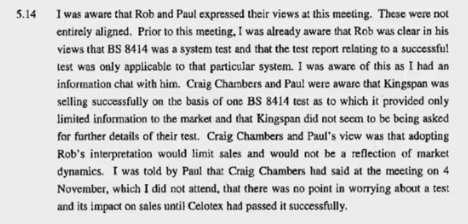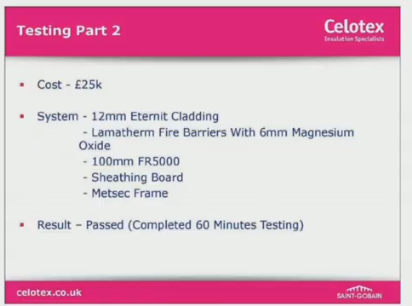
Lunchtime update from the inquiry:
- Former product manager at Grenfell insulation manufacturer Celotex calls company's actions 'unethical' and 'dishonest'
- Company secured fire test pass by adding fire resistant board
- Jon Roper told to remove references to these alterations
- Former product manager at Grenfell insulation manufacturer Celotex calls company's actions 'unethical' and 'dishonest'
- Company secured fire test pass by adding fire resistant board
- Jon Roper told to remove references to these alterations

So inquiry this morning has been discussing Celotex's test at the Building Research Establishment in May 2014. This was crucial in persuading the market that its product could be used on buildings above 18m. We already knew it used additional magnesium oxide (fire resisting)...
... boards in key locations near temperature monitors. Today Jon Roper - who was leading this project - said the whole senior management team knew of this strategy. Aged only 23, he was very uncomfortable with it, but says he felt he had to go along with what he was told.
The story we heard this morning started in 2013 when Roper was researching how its competitor Kingspan was winning business on tall buildings, despite regulations prohibiting combustible insulation from use at this height.
He deduced that what the firm had done was to get through a system test using a cladding panel made of cement particle board in front of its product and then market it pretty hard as compliant for use on tall buildings per se
There was a divide, he said, within Celotex. Some members of the team wanted to follow this Kingspan route. Others wanted to test a system and accurately describe that in its marketing (Celotex could only be used in the system as tested)
He noted in an email that trying to do the latter (or the right thing as he called it) would "limit us hugely" and require a massive marketing campaign, as well as potentially attracting legal action from Kingspan 

In the same email, he floated the idea that perhaps Celotex should back away from the above 18m market as "in the event of a fire it will burn". He says this was not the only time he suggested this as a potential route. 

Asked if it was "the only option consistent with honesty and plain dealing", he said yes. He said it quickly became apparent to him that this was not the route Celotex was going to take. "I think the business had decided that was the road it was going to go down regardless."
He presented this research at a meeting of senior managers in November 2013 (Craig Chambers is the MD). There is differing opinion between the technical team (who want to present it as a system test) and the commercial (who want to maximise sales) 

There is then a test in February 2014. Celotex fails pretty badly (flames go above the rig). But it is decided that it may have a shot at passing if it uses a thicker external cladding panel. Roper's evidence is that this suggestion came from a BRE staff member 

They then decide to retest with the inclusion of fire retardent magnesium oxide boards and thicker cladding panels. Again Roper says the senior management were aware of this strategy, and that he had "no doubt" the BRE knew it was happening as well.
The build up was designed so the thicker boards wouldn't poke out in photos and be visible in the test report. Didn't this strike you as dishonest at the time, asks Millett.
"I went along with a lot of actions at Celotex that looking back on reflection were completely unethical... I was 22/23, first job. I thought this was standard practice, albeit this did sit very comfortably with me"
This test is carried out in May and passes. Roper prepares a slideshow about it for senior management which includes reference to the failed February test and the change to include new boards and thicker cladding 

He is then asked to prepare new slides which cut out all reference to the failed test in february and the changes to the build up. He does this.
Asked if this was "downright misleading" and a "fraud on the market" if sold in this was, he says yes.
"I lived with my parents at this time and I recall going home in the evening and mentioning this to them and I felt incredibly uncomfortable with what I was being asked to do"
"I lived with my parents at this time and I recall going home in the evening and mentioning this to them and I felt incredibly uncomfortable with what I was being asked to do"
Mr Roper continues after lunch
• • •
Missing some Tweet in this thread? You can try to
force a refresh




